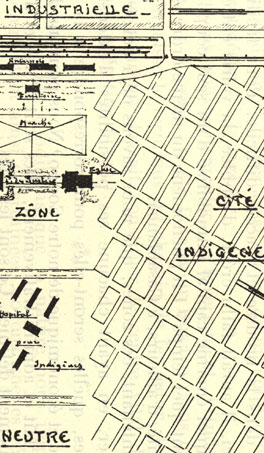THE 'COLOUR BAR'
 Plan of a Congolese city Plan of a Congolese city |
The colonial system is one of legal inequalities between colonizers and colonized, based on 'racial' differentiation. Unlike the Belgian Constitution, its equivalent in the colony, the Colonial Charter, recognizes the existence of different 'races'. The colonial administration categorizes the Congolese population by distinguishing 'races' and ethnic groups and further classifies individual Congolese according to their level of 'civilization'. Congolese hold Belgian nationality with colonial status: being subjects, they can never attain citizenship or enjoy the same rights as Belgians. Colonial society is very diverse: Belgians, Congolese, and many nationalities and lines of descent – African, Asian and European. Greeks, Portuguese and European Jews are not considered Europeans but make up an intermediate class. A 1918 decree imposes the separation of the 'races' in cities: this segregation is most evident in Katanga, an industrial region whose economy depends on the copper belt that stretches to South Africa. Maintaining segregation involves banning sexual relations between Africans and Europeans. Marriage isn't forbidden but it is rare, limited to unions between European men and African women, as the administration doesn't even consider the possibility of an African man marrying a European woman.
|



